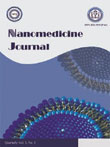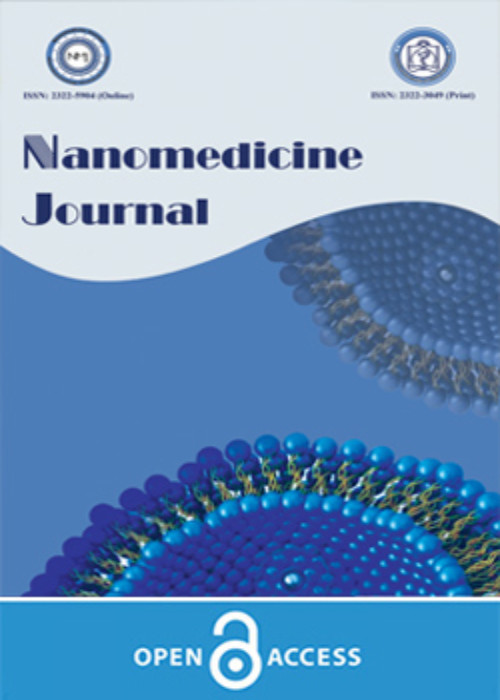فهرست مطالب

Nanomedicine Journal
Volume:1 Issue: 1, Autumn 2013
- تاریخ انتشار: 1392/03/13
- تعداد عناوین: 7
-
-
Page 1Niosomes, non-ionic surfactant vesicles (NSVs), are the hydrated lipids composed mainly of different classes of non-ionic surfactants, introduced in the seventies as a cosmetic vehicle. Nowadays, niosomes are used as important new drug delivery systems by many research groups and also they are effective immunoadjuvants which some commercial forms are available in the market. These vesicles recently used as gene transfer vectors as well. This review article presents a brief report about the achievements in the field of nanoscience related to NSVs. Different polar head groups from a vast list of various surfactants with one, two or three lipophilic alkyl, perfluoroalkyl and steroidal moieties may be utilized to form the proper vesicular structures for encapsulating both hydrophilic and hydrophobic compounds. The methods of niosome preparation, the vesicle stability related aspects and many examples of pharmaceutical applications of NSVs will be presented. The routes of administration of these amphiphilic assemblies are also discussed.Keywords: Non, ionic surfactants, Drug delivery, Nano, niosomes
-
Page 14The use of biogenic selenium nanoparticles for various purposes is going to be an issue of considerable importance; thus, appropriate simple methods should be developed and tested for the synthesis and recovery of these nanoparticles. In this study, a fungus was isolated from a soil sample, identified as Aspergillus terreus and used for extracellular synthesis of selenium nanoparticles (Se NPs). UV–Vis spectroscopy and energy dispersive X-ray spectrum studies were carried out to confirm Se NPs formation within 60 min. Dynamic light scattering and scan electron microscopic methods were also used to characterize both size and shapes of the Se NPs. The results show that spherical particles with average size of 47 nm were formed by adding a culture supernatant of A. terreus to selenium ions solution. This approach appears to be an easy and appropriate method for extracellular synthesis of small Se NPs. Extracellular synthesis of small Se NPs has not been reported yet.Keywords: Selenium nanoparticle, Aspergillus terreus, Soil, Synthesis, Extracellular
-
Page 21Aligned and random nanocomposite nanofibrous scaffolds were electrospun from polycaprolactone (PCL), poly (vinyl alcohol) (PVA) and hydroxyapatite nanoparticles (nHA). The morphology and mechanical characteristics of the nanofibers were evaluated using scanning electron microscopy and tensile testing, respectively. Scanning electron microscopy revealed fibers with an average diameter of 123 ± 32 nm and 339 ± 107 nm for aligned and random nanofibers, respectively. The mechanical data indicated the higher tensile strength and elastic modulus of aligned nanofibers. The in vitro biocompatibility of aligned and random nanofibrous scaffolds was also assessed by growing mesenchymal stem cells (MSCs), and investigating the proliferation and alkaline phosphatase activity (ALP) on different nanofibrous scaffolds. Our findings showed that the alignment orientation of nanofibers enhanced the osteogenic differentiation of stem cells. The in vitro results showed that the aligned biocomposite nanofibrous scaffolds of PCL/nHA/PVA could be a potential substrate for tissue engineering applications, especially in the field of artificial bone implant.Keywords: Electrospinning, Nanofibers, Bone tissue engineering
-
Page 30An inoculation of virulent Leishmania major is known as leishmanization (LZ) which is proven to be the most effective control measure against Cutaneous Leishmaniasis (CL). However, using LZ is restricted due to various side effects such as uncontrolled lesion development. In the present research, the efficacy of cationic nanoliposomes containing CpG oligodeoxynucleotides (CpG ODN) as an improved adjuvant delivery system was studied to diminish the lesion development and infection course of L. major after inoculation into the mice. BALB/c mice were inoculated subcutaneously (SC) with L. major plus empty DSPC, DSPC (CpG ODN), DSPC (Non CpG ODN), empty DMPC, DMPC (CpG ODN), DMPC (Non CpG ODN) or HEPES buffer. The results showed that group of mice received DMPC (CpG ODN) nanoliposomes developed a significantly smaller lesion and showed minimum number of L. major in the spleen and draining lymph nodes. In addition, using DMPC (CpG ODN) liposomes resulted in a Th1 type of immune response with a preponderance of IgG2a isotype which is concurrent with the production of DMPC (CpG) induced IFN-γ in the spleen of the mice. Taken together, the results suggested that immune modulation using DMPC (CpG ODN) nanoliposomes might be a practical approach to improve the safety of LZKeywords: DMPC (CpG ODN) nanoliposomes, CpG ODN, L. major, Leishmanization, Immune response
-
Page 41Topical retinoids are considered as the first line therapy in the treatment of acne vulgaris, but they are associated with cutaneous irritation. In this study, isotretinoin-loaded solid lipid nanoparticles(IT-SLN) were prepared to treat the mild to moderate acne. Also using IT-SLN would minimize IT adverse effects in comparison to commercial product, Isotrex®. This study was conducted to prepare and characterize IT-SLN and assessing the efficiency of IT-SLN comparing to Isotrex® acne. IT-SLN was prepared using hot high pressure homogenization method. IT-SLN contained 0.05% IT in 5% of lipid phase (Glyceryl monostearate- GMS) and tween 80 (2.5 % w/v) was used as surfactant in the aqueous phase. IT-SLN was characterized by particle size analyzing, differential scanning calorimetry and transmission electron microscopy. Encapsulation efficacy was also obtained using spectrophotometry. The efficacy of IT-SLN was evaluated in a randomized, single-blind, parallel-group study and compared with Isotrex®. Forty patients encountered in the study and divided in two groups. Treatment regimen was once-nightly topical administration accompanied with topical administration of clindamycin 2% solution twice a day for 8 weeks. The particle size of IT-SLN was around 60 nm with PDI of 0.4 and zeta potential was about -40 mV. Encapsulation efficacy of IT in SLN in crystalline form was 84±0.21%. IT-SLN produced significantly better treatment than Isotrex® in both non-inflammatory and inflammatory lesions according to its recovery percent after 8 weeks. Also IT-SLN gained better global assessment scores. Our results showed that IT-SLN had higher efficacy than Isotrex® to clear non-inflammatory and inflammatory lesions.Keywords: Solid lipid nanoparticles (SLN), Isotretinoin, Acne, Clinical trial
-
Page 52A lot of researches have investigated the effects of topical cyclosporine A on the eye surface layers’ diseases. By now the main limitation in cyclosporine application is the low permeation of the drug into the posterior segments of the eye. The aim of present study was to formulate high permeable dosage form can be beneficial in the topical treatment of the uveitis. To reach higher corneal drug absorption and drug concentration in the posterior segments of the eye, 3 nanoliposomal formulations containing 0.5 mg/ml cyclosporine A were prepared. Liposomal formulations and the commercial product (Restasis®) were instilled in the right and left eyes of the rabbits, respectively. The rabbits were killed in the 3, 7, 14 and 28 days of study and the aqueous humor and vitreous were extracted. Mean size of liposomal formulation number 1, number 2 and number 3 were 107.2 ± 0.7, 129.3±0.9 and 144.8±1.8 nm and their zeta potential were -5.0±1.7, -5.5±2.3 and 44.6±6.2 mV, respectively. Results of ocular analysis showed that the liposomal formulations could increase the concentration of the drug in the aqueous and vitreous like Restasis®. But, in contrast with what has been expected the findings of this study implicate nanoliposomal formulations prepared could not make a significant difference in concentration of the drug in aqueous and vitreous humor compared to Restasis® (anionic microemulsion). In conclusion, we can state that liposomes with the same composition as our formulations are not more efficient than microemulsion for cyclosporine as ophthalmic drug delivery.Keywords: Cyclosporine A, Nanoliposome, Restasis®, Posterior segment
-
Page 59Among synthetic carriers, dendrimers with the more flexible structure have attracted a great deal of researchers’ attention in the field of gene delivery. Followed by the promising results upon hydrophobic modification on polymeric structures in our laboratory, alkylcarboxylated poly (propylenimine)-based carriers were synthesized by nucleophilic substitution of amines with alkyl moieties and were further characterized for their physicochemical and biological characteristics for plasmid DNA delivery. Although not noticeably effective gene transfer activity for hexanoate- and hexadecanoate-modified series was observed, but alkylation by decanoic acid significantly improved the transfection efficiency of the final constructs up to 60 fold in comparison with unmodified poly(propylenimine) (PPI). PPI modified by 10-bromodecanoic acid at 50% grafting, showed significantly higher gene expression at c/p ratio of 2 compared to Superfect as positive control. Overall, modification of PPI with 50% primary amines grafting with 10-bromodecanoic acid could increase the transfection efficiency which is occurred at lower c/p ratio when compared to Superfect, i.e. less amount of modified vector is required to exhibit the same efficiency as Superfect. Therefore, the obtained constructs seem to be safer carriers for long-term gene therapy applications.Keywords: Poly (propylenimine), Alkylation, Hydrophobic modification, Gene delivery


